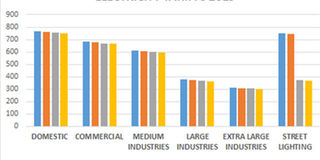ERA reduces power tariffs by Shs2.4 for 2019 last quarter

Slight reduction. ERA has since the beginning of the year slightly reduced power tariffs although some consumers continue to insist the charges are still high and unaffordable.
KAMPALA. Electricity Regulatory Authority has reduced power tariffs by an average of Shs2.4 for the last quarter from October to December.
The reduction will apply to all consumption categories including domestic and extra large consumers.
The first 15 units for domestic consumers have been maintained at Shs250 with the sixteenth unit upwards now costing Shs752.5 per unit from Shs755.1 in September.
Commercial consumers will during the period enjoy Shs3.4 tariff reduction from Shs669.5 to Shs666.1 while medium industrial users will pay Shs595.6 per unit from Shs599.2 reflective of a shs3.6 reduction. Large industries will pay Shs364 from Shs365.7, saving industrialists Shs1.7.
Extra-large industries on the other hand will save Shs2.1 in the three months leading to December, paying Shs302.6 per unit from Shs304.7 in the previous quarter.
ERA has maintained its strategy to continue reducing tariffs on street lighting, which were reduced by almost a half last month to Shs371.4 per unit.
Government will now pay Umeme even less by Shs1 within October to December at Shs370.4 per unit for street lights.
ERA approves tariffs determined on the basis of changes in international fuel prices, exchange rate, inflation and Energy Generation Mix. The tariffs have been set against low inflation and a relatively stable exchange rate of Shs3689.33 against the dollar.
International fuel prices, despite turbulences, such as the Saudi Arabia bombing, reduced to $59.62 per barrel in September from $69.97 in June.
Annual changes
The electricity supply industry has seen developments this year, especially with the commissioning of 183 megawatt Isimba dam in March.
Though under utilised, Isimba is expected to sequentially drop the average price of electricity bought across all power generating sources since its power costs only 4 cents.
Resultantly, having an effect on the final cost of electricity. However, to achieve this, more consumption of electricity must be realised. Since the beginning of the year, the regulator’s biggest power cut has been street lighting by Shs380 while domestic consumers pay Shs16 less currently than they did in January.




